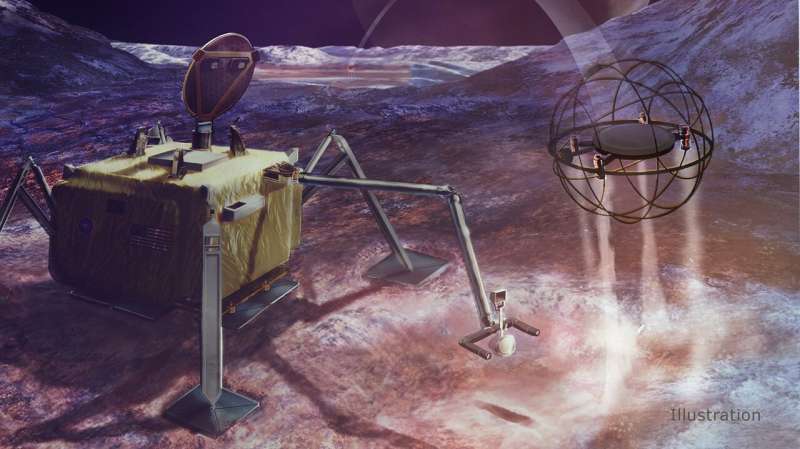This article has been reviewed according to Science X's editorial process and policies. Editors have highlighted the following attributes while ensuring the content's credibility:
fact-checked
trusted source
proofread
A hopping robot could explore Europa using locally harvested water

Various forms of hopping robots have crept into development for use in different space exploration missions. We've reported on their use on asteroids and even our own moon. But a study funded by NASA's Institute for Advanced Concepts (NIAC) in 2018 planned a mission to a type of world where hopping may not be as noticeable an advantage—Europa.
The mission, developed by engineers at NASA's Jet Propulsion Laboratory, Purdue University, and Honeybee Robotics, is known as the Steam Propelled Autonomous Retrieval Robot for Ocean Worlds, or SPARROW. It's about the size and shape of a soccer ball, with the logic, power, and control systems inside a spherical outer hollow shell.
SPARROW wouldn't be able to operate on its own, however. It would require a lander to deposit it onto the surface and serve as a refueling and sample collection storage base. Europa Clipper, the only currently planned NASA mission to the icy moon, would have been good for hitching a ride, but its lack of a lander made it unsuitable for SPARROW.
However, the hopping robot itself is well suited for the environment in Europa. Its designers intended to make it "terrain agnostic," meaning it could traverse even the harshest terrain the icy moon could throw at it. These would include penitentes, shards of ice that could be meters tall, and difficult for ground-based robots to traverse.
SPARROW could fly over them, collect interesting samples, and return to the lander to refuel and deposit them. Then, it could go out again in a different direction. To model this system architecture, the JPL team spent Phase I trying to determine the best propulsion system for the robot and modeling control algorithms for the flights.
First, let's tackle the propulsion system. The lander accompanying SPARROW would have to mine ice off the moon's surface, then heat it and store it as water. When SPARROW returned from a hop, it would use the water to refuel.
Five different propulsion methods were considered as part of the study. Still, the best turned out to be a "hot water thruster," where SPARROW would internally heat the water supplied by the lander, then eject that out in a burst of propulsive force to launch the robot off the surface.
The second major part of the paper was controlling that propulsion. Trajectory correction is critical to mission success, but in this case, the designers believe that no matter where the robot ends up, it will be able to collect a sample and return to the lander. This is due to its gimballed design, which allows the robot to consistently orient correctly, even after bouncing along a frozen surface for a while.
There is still much work to do before the mission is ready to go, though. Some of the most pressing questions are how to stop ice from forming in the robot's propulsion nozzle and throughout its structural cage. Such blockages could easily throw off any existing trajectory calculations and theoretically immobilize the hopper entirely if they were severe enough.
However, no work is planned to solve those problems for now as the project has yet to receive Phase II funding from NIAC, and work on it appears to have stalled. Dr. Gareth Meirion-Griffith, the primary investigator on the project, has moved on from JPL to take a job at Collins Aerospace. Even so, someday, the author's ideas might be integrated into a Europa lander mission—we'll have to wait and see.
Provided by Universe Today





















